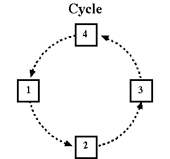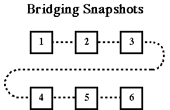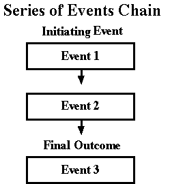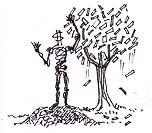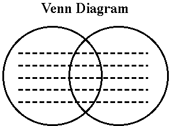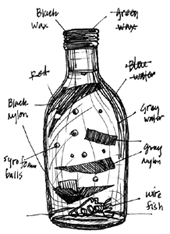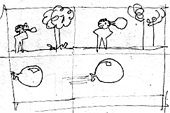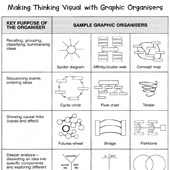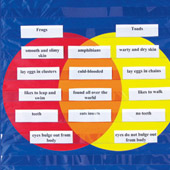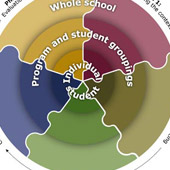- HOME
-
- Our Vision & Mission
- Core Values
- Core Principles
- School Pledge
- What's in a Name?
- History
- Facilities
- Quality Management
- Governing Body
- School Timings
- Message from School Committee
- Theory Of Action
- CBSE compliance
- CBSE AFFILIATION
- MANDATORY PUBLIC DISCLOSURE
- ANNUAL REPORT
- CERTIFICATE OF RECOGNITION
- TRANSFER CERTIFICATES
- BOOK LIST
- TRUST DETAILS
- BUILDING SAFETY CERTIFICATE
- FIRE SAFETY CERTIFICATE
- SANITATION CERTIFICATE
- FEE STRUCTURE
- BOARD EXAMINATION RESULT
- SELF CERTIFICATION
- NO OBJECTION CERTIFICATE
- STUDENT DETAILS
- Alumni
- MAKE A PAYMENT
Quick Links
Photo Gallery
Graphic organizers
What are Graphic Organizers ?
A graphic organizer is a visual communication tool that uses visual symbols to express ideas and concepts, to convey meaning. A graphic organizer often depicts the relationships between facts, terms, and or ideas within a learning task. It is often referred to as a "map" because it can help teachers and students "map out" their ideas in a visual manner. There are many similar names for graphic organizers including: knowledge maps, concept maps, story maps, cognitive organizers, advance organizers, or concept diagrams.
What is its purpose?
The main purpose of a graphic organizer is to provide a visual aid to facilitate learning and instruction. Most graphic organizers form a powerful visual picture of information and allow the mind 'to see' undiscovered patterns and relationships. Although they have been applied across a range of curriculum subject areas, reading is by far the most well practiced application. Science, social studies, language arts, and math are more recent areas in which graphic organizers are being applied.
How do I do it?
In 1992, Jay McTighe in his book Graphic Organizers: Collaborative Links to Better Thinking outlined three main ways teachers may use graphic organizers in their teaching and a number of ways that students can use them to aid in the learning process.
Before instruction, teachers may use a graphic organizer to attempt to provide structure for the presentation of new material while indicating relations between ideas. Teachers can elicit information from students by creating a graphic organizer on the blackboard to get an accurate idea of students' prior knowledge
During instruction, graphic organizers can help students to actively isolate, process and reorganize key information. This is because graphic organizers allow students to approach subjects cognitively because they assist thinking. The student must take an active role in learning while processing and reorganizing information. Modifying an organized structure of information gives students an opportunity to learn from their own mistakes. It also allows students to construct maps that are appropriate to their individual learning styles.
After instruction, students can construct their own organizers using the full text to isolate and organize key concepts. This summarization technique is a tool to see if students can interpret what was being taught and state it in concise, accurate terms. Post-instruction graphic organizers also encourage elaboration. If a student can connect prior knowledge with what was learned and identify relationships between those ideas, they are actively learning. When introducing students to a newgraphic organizer, you should describe its purpose, model its use, and provide students with opportunities for guided practice. Once students become comfortable with using the organizer, more independent applications are appropriate. In the end, you should encourage and assist students to create their own organizers.
How can I adapt it?
- Early Childhood Adaptations
- Teaching children about animals and helping them classify the animals
- Explaining the connections between characters in a story Developing language skills by including pictures along with the words within the graphic organizer to explain a certain concept
- Elementary Adaptations
- Helping children remember or understand the specific parts of a story
- Using phonological awareness activities, teaching the children how and when to spell the various /s/ sounds, for example.
- Helping children remember the provinces and capitals and where they are located in Canada. For example – the Maritime Provinces, the Eastern Provinces, the Western Provinces.
- Middle Years Adaptations
- Illustrating Science concepts, such as how and when various types of clouds form
- Understanding history concepts, such as the key issues leading to the Civil War.
- Associating the instruments in an orchestra with the particular section that instrument might be in. One section of the graphic organizer might be entitled "woodwind instruments," with the specific instruments noted.
Assessment and Evaluation Considerations
The way that you evaluate graphic organizers depends a great deal on the graphic organizer being evaluated. A generic rubric for evaluating student and teacher made graphic organizers might be a useful tool for evaluating the effectives of a specific graphic organizer type.
If you wish to evaluate the effect that using a specific graphic organizer had in students reaching a learning goal or objective, then other assessment tools and techniques will be needed.
Teacher Resources
Graphic Organizers (Grades K-8), Karen D'Angelo Bromley , Linda Irwin-Devitis , Marcia Modlo, 01 January, 1999 ISBN: 0590489283
Graphical Organizers as Thinking Technology - an article by James McKenzie
Rubric for a Graphic Organizer (Inspiration)
Graphic Organizers from NCREL - gives specific examples of graphic organizers such as K-W-L-H (Know, Want, Learn, How), Anticipation Reaction Guide, Spider Map, Series of Events Chain, Continuum Scale, Compare/Contrast Matrix, Problem/Solution Outline, Network Tree, Human Interaction Outline, Fishbone Map and Cycle.
Graphic Organizer Printables from Teacher-Vision.com - These graphic organizers will help you and your students organize ideas and concepts.
Online Graphic Organizer Generators
Graphic Organizers from Education Place - PDF's of many graphic organizers
WriteDesign On-Line - Graphic Organizers - explains the five main types of organizers with examples
Learning Resources: Graphic Organizers
ABC's of the Writing Process - Specific Graphic Organizers Links
Graphic Organizers from Houghton Mifflin
Graphic Organizers from the Four Blocks Approach
Graphic Organizers for Content Instruction - from ESL net
Graphic Organizers from Scholastic.com


 SCHOOL CALENDAR
SCHOOL CALENDAR LATEST ANNOUNCEMENT
LATEST ANNOUNCEMENT





